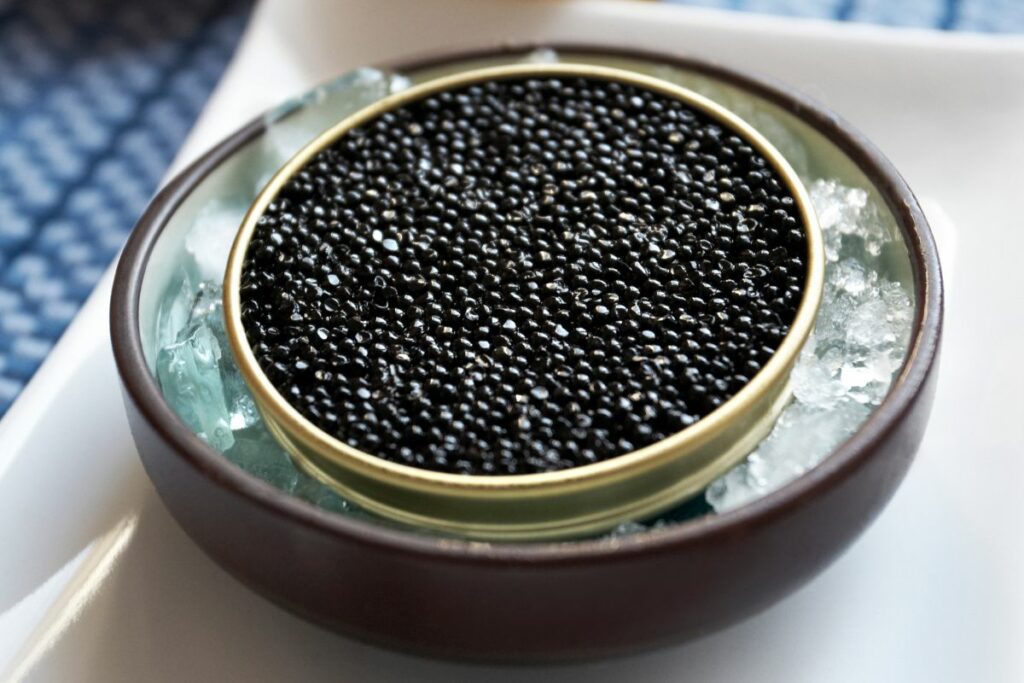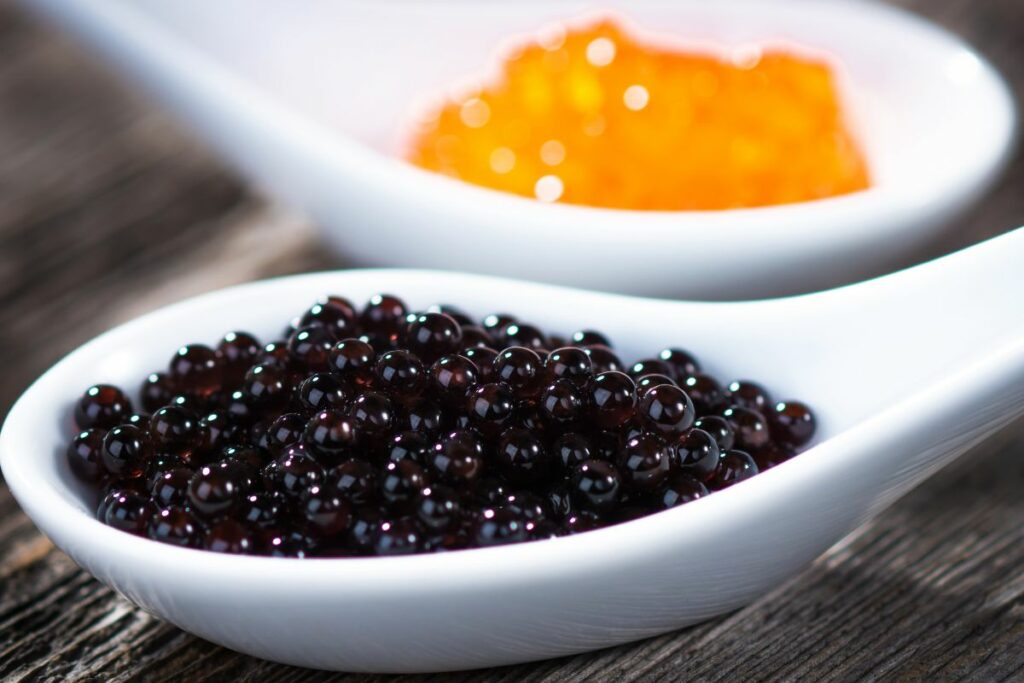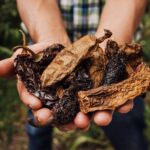A symbol of luxury and culinary sophistication, caviar has captured the imagination and palates of gourmands for centuries.
This article will take you on a journey to unravel the mysteries of this exquisite delicacy. From its origins in the Caspian Sea to the meticulous process of harvesting and grading, we will delve into the fascinating realm of caviar.

Each delicate pearl bursts on the tongue, releasing a complex blend of briny, buttery, and nutty flavors that create an unforgettable sensory experience. Join us as we dive deeper into the origins, harvesting methods, and cultural significance of caviar.
What Is Caviar?
Caviar refers to the salted roe (eggs) of certain species of sturgeon, a prehistoric fish that inhabits the pristine waters of select regions.
Renowned for its distinct flavor and unique texture, caviar is celebrated for its indulgence and rarity. It has long been associated with elegance, opulence, and the highest echelons of culinary experiences.
Throughout history, caviar has captivated the palates of royalty, aristocracy, and discerning connoisseurs. Its consumption is steeped in tradition and cultural significance, often seen as a symbol of celebration and sophistication.
From lavish banquets to exclusive soirées, caviar has played a prominent role in haute cuisine and gastronomic events.
Different varieties of caviar exist, each distinguished by the species of sturgeon and the region in which it is sourced.
Beluga, Osetra, and Sevruga are among the most sought-after types, each possessing its own unique flavor profile, color, and size of roe. The rarity and limited availability of these precious eggs contribute to their exceptional value and allure.
Caviar is typically enjoyed in its purest form, served chilled and traditionally accompanied by blinis, toast points, or delicate crème fraîche.
Origins Of Caviar
The origins of caviar can be traced back to ancient times when sturgeon roe was first enjoyed as a delicacy. The sturgeon, a prehistoric fish species, thrived in the Caspian Sea and Black Sea regions, where caviar production initially flourished.
Historically, caviar was consumed by the nobility and aristocracy of Persia (present-day Iran) and later gained popularity among the royal courts of Russia. The Caspian Sea, particularly the areas of Russia, Iran, and Azerbaijan, became renowned for their high-quality caviar production.
The prized roe came primarily from three species of sturgeon: Beluga, Osetra, and Sevruga. Beluga caviar, known for its large-sized eggs and delicate flavor, was considered the epitome of luxury.
Osetra caviar, with its medium-sized eggs and varied colors, offered a rich and complex taste. Sevruga caviar, featuring smaller eggs and a robust flavor profile, provided a distinctively briny experience.
As caviar gained international acclaim, demand grew exponentially, leading to overfishing and environmental concerns. To protect sturgeon populations and ensure sustainability, regulations and conservation efforts have been implemented in recent decades.
These measures include farming sturgeon in controlled environments, implementing quotas, and promoting responsible harvesting practices.
Today, caviar production extends beyond the Caspian Sea region, with countries such as the United States, France, Italy, and China cultivating sturgeon and producing high-quality caviar.
Sustainable aquaculture practices have become increasingly prevalent, allowing for the availability of caviar while protecting wild sturgeon populations.
As the global appreciation for caviar continues to grow, connoisseurs have the opportunity to explore an array of caviar options, from traditional Caspian caviar to innovative alternatives.
Whether enjoying the time-honored classics or discovering new varieties, the origins of caviar remain steeped in history, tradition, and the allure of an extraordinary culinary experience.
Caviar Harvesting Methods

The harvesting of caviar involves precise and delicate methods to ensure the quality and integrity of the roe. Here are the two primary techniques used in caviar production:
Traditional Or Wild Harvesting
Historically, caviar was obtained through traditional or wild harvesting methods, which involved catching wild sturgeon from their natural habitats.
Skilled fishermen would carefully catch the sturgeon, usually in nets or by hand, and then extract the roe from the captured fish. This method required extensive knowledge of the fish’s behavior and migration patterns.
However, due to overfishing and the declining sturgeon populations in the wild, this method has become increasingly regulated and restricted.
Many countries have implemented fishing bans and conservation measures to protect the sturgeon species from extinction and promote sustainable caviar production.
Aquaculture Or Farmed Caviar
As a response to the decline of wild sturgeon populations, aquaculture or farmed caviar has emerged as a sustainable alternative.
Sturgeon are bred and raised in controlled environments, such as specially designed ponds or tanks, to mimic their natural habitat conditions.
Farmed sturgeon are carefully nurtured and provided with a controlled diet to ensure optimal health and quality of the roe. The maturity of the sturgeon is monitored, and when the time is right, the eggs are harvested.
This process often involves gently massaging the abdomen of the female sturgeon to extract the ripe eggs, a technique known as “stripping” or “milking.” The extracted eggs are then carefully processed and salted to create caviar.
Aquaculture not only protects wild sturgeon populations but also allows for greater control over the quality and consistency of the caviar.
It also provides opportunities for innovation, such as experimenting with different sturgeon species and exploring new flavor profiles.
Both traditional and farmed harvesting methods contribute to the availability of caviar in the market today. Responsible producers prioritize sustainable practices, ensuring the long-term viability of caviar production while preserving the delicate ecosystem of sturgeon habitats.
Final Thoughts
Caviar is an extraordinary delicacy that has captivated the world with its luxurious appeal and distinctive flavor.
Originating from the roe of sturgeon, caviar has a long history steeped in tradition and has been enjoyed by royalty, aristocracy, and discerning palates for centuries.
Caviar continues to be celebrated for its exquisite taste and unique texture. Each delicate pearl bursts with a complex blend of flavors, ranging from briny to buttery, offering a truly indulgent culinary experience.
As caviar enthusiasts explore the world of this coveted delicacy, they can appreciate the craftsmanship, sustainability efforts, and cultural significance associated with its production.
Whether sourced from traditional regions or innovative aquaculture farms, caviar remains a timeless treasure that elevates any dining experience to new heights of elegance and sophistication.
- How To Reheat A Cheesesteak - November 5, 2023
- What Are Three Must Have Kitchen Knives? - September 22, 2023
- How To Protect Edges Of Pie Crust - June 15, 2023








